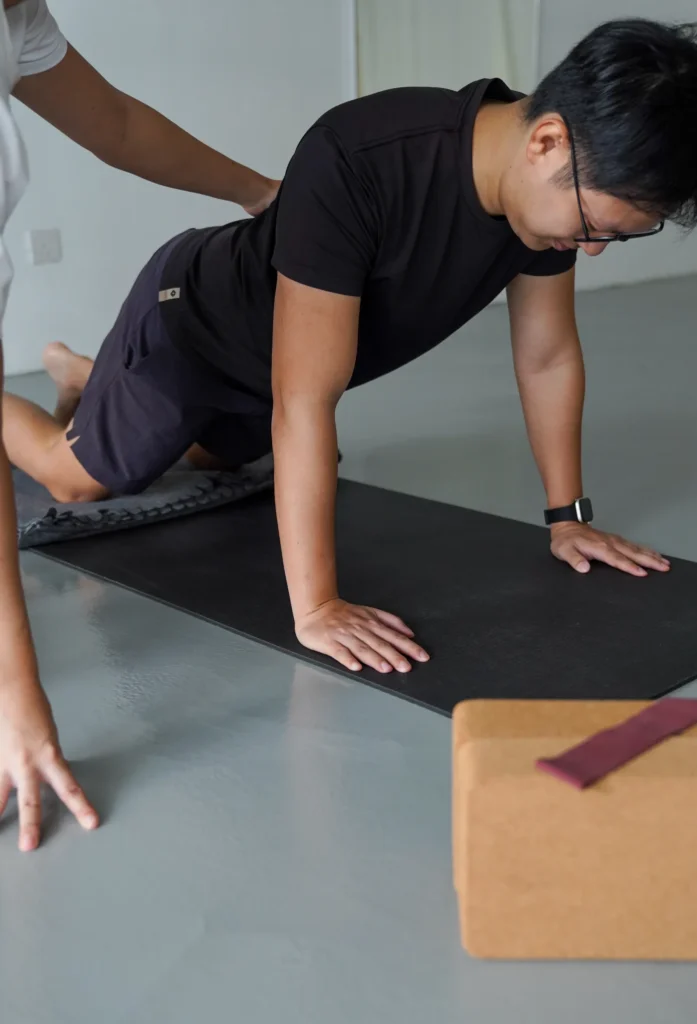Discover the secrets to a safe and fulfilling prenatal Yoga practice in our latest blog post, “Flowing Through Pregnancy: Safe Yoga Tips.” Elevate your pregnancy journey with expert guidance.
Introduction
Pregnancy is a transformative journey, both physically and emotionally. Having a prenatal Yoga practice during this special time can be a profound way to nurture the body, mind, and spirit. Let’s explore the numerous benefits of prenatal yoga and how to practice it safely for an enriching experience.
Benefits of Prenatal Yoga
Prenatal Yoga is a Yoga practice that honours the journey of pregnancy through movements, breathing exercises and meditations that are all adapted to support the needs of a pregnant body. It offers a host of benefits that can extend beyond the pregnant practitioner to the life growing within.
Physical benefits of Prenatal Yoga
Pain Relief
Many pregnant people begin a prenatal Yoga practice for the physical benefits that it offers, namely: helping to ease the aches and strains that accompany changing body dynamics. As baby grows, the uterus expands causing postural changes and pressure on various tissues, organs, bones, and sometimes nerves in the body. This can result in discomfort and sometimes pain. For this reason, a movement practice like Yoga, which offers gentle stretches, mobility, and strengthening exercises for important postural muscles, can be a soothing balm of relief for achey muscles and joints.
Circulation
As the uterus expands it may also press on veins causing fluid to build up in the legs and feet. The practice of Yoga is wonderful for promoting blood circulation which can help to ease symptoms like swelling. Postures like, legs-up-the-wall can be especially helpful for releasing pressuring and swelling in the ankles and feet.
Improves Elimination
During pregnancy, hormones called progesterone and relaxin are released into the blood stream. These hormones loosen the muscles in the digestive tract that facilitate the movement of food and waste, resulting in constipation. Movement is known to be helpful in improving elimination as it provides a gentle massage for the internal organs, such as the digestive tract. So, having a regular prenatal Yoga practice can improve digestion and regulate elimination.
Strength Building
A prenatal Yoga practice can help to cultivate the strength and endurance necessary for birth and beyond. Learning how to relax and engage the pelvic floor muscles, is also a tenet of prenatal Yoga that is essential for an easeful birth and postpartum recovery.
Body Awareness
The body contains infinite wisdom which it communicates through sensation. Yoga is a practice that fosters body awareness which can be instrumental for recognising the signs of labour and harnessing the inner strength needed for birth.
Mental benefits of Prenatal Yoga
Pregnancy can be a whirlwind of emotions. A prenatal Yoga practice provides a quiet, non-judgemental space to process those feelings while tools such as breathing exercises, meditation and even chanting create a mind-and-body connection that soothes overactive nervous systems. This relieves symptoms of stress, anxiety, and induces a feeling of calm.
Spiritual benefits of Prenatal Yoga
Especially during the first trimester when baby is still small and movement may not be detectable, it can be challenging to feel connected to the life growing within. The practice of prenatal Yoga is therapeutic for cultivating this communication and connection through touch, postures, visualisation meditations, and belly breathing techniques.
Preparing for a Safe Practice
Before embarking on a prenatal yoga journey, a few preparatory steps are essential for ensuring a safe and fulfilling practice.
Acknowledge that Pregnancy is a Special Time
Pregnancy is a unique moment and it deserves to be treated as such. It can be helpful to remember that during this time it may be necessary to adapt certain poses, familiar movements may feel different, and energy levels may fluctuate from day to day—that’s okay! A supportive prenatal Yoga practice will honour the different ebbs and flows of the pregnancy journey.
Every Pregnancy is Unique
Even if this is a second pregnancy, it is important to acknowledge that this pregnancy is unique and will have its own experiences. Avoid comparisons especially to other people’s pregnancies or prenatal Yoga journeys. Every body is different and every pregnancy is different.
Consultation with Healthcare Provider
Before initiating any new exercise regimen during pregnancy, it is essential to consult your health care provider. They can offer tailored advice based on your medical history, pregnancy, and health requirements ensuring Yoga is a suitable movement practice.
This list is not exhaustive, but here are some examples of questions that you may consider asking your healthcare provider before attending prenatal Yoga:
- Is prenatal Yoga a safe movement practice for me during my pregnancy?
- Are there any movements/exercises/positions I should avoid?
- Do you have any nutritional advice for me to follow before and after my Yoga practice?
- What are some warning signs that I should look out for while I am practicing?
- Who should I contact if I need medical help/assistance during class?
Selecting the Right Yoga Instructor
A trained prenatal yoga instructor will have expertise in adapting poses and sequences to suit the needs of pregnant Yoga practitioners. A thorough search (eg: “ prenatal Yoga instructors near me ” or more specifically, “ private prenatal yoga instructors near me ” ) can help in locating a prenatal Yoga specialist in your local community. Because pregnancy is such a special time, it is recommended to find someone that you feel comfortable working with. Opting for a private prenatal Yoga class can be an invaluable experience for developing your foundational knowledge of prenatal Yoga especially if you are new to the practice of Yoga.
Suitable Clothing and Equipment
Staying comfortable and cool is especially important during a prenatal yoga practice. Pregnant bodies usually have a higher body temperature which can result in excess sweating even in the most gentle prenatal Yoga classes. For this reason it is important to wear comfortable, breathable, sweet-wicking clothing that will allow for unrestricted movement. Having a towel close-by is useful to wipe sweat or any wet surfaces to avoid slipping. Investing in a quality yoga mat also provides a supportive and stable practice surface. Likewise, bolsters, blankets and blocks are excellent for additional cushioning and support when needed.
Essential Precautions for Prenatal Yoga
Safety should always be at the forefront of any prenatal yoga practice.
Understanding Physical Limitations
Pregnancy brings about unique physical limitations. Being mindful of these and avoiding overexertion is crucial.
Avoiding High-Risk Poses
Certain yoga poses, especially those involving deep twists, abdominal engagement (particularly the rectus abdominus), and deep backbends are best avoided during pregnancy. These poses can exert undue strain on the muscles of the abdomen, posing potential risks to the postpartum recovery.
Additionally, because Relaxin is present in all of the muscles and connective tissues of the body it is recommended to avoid intense stretching or heavy weight-bearing on joint areas of the body.
When practicing Yoga poses that involve balancing, it is best to seek support (eg: holding onto a chair or a wall) to prevent falls.
Finally, after the first trimester it is advised to avoid reclined postures like Savasana (Corpse Pose) as baby’s weight may put pressure on the inferior Vena Cava, a vein that transmits blood to the heart. Therefore, for relaxation it is better to opt for a semi-reclined or a side-laying position.
Staying Hydrated
Proper hydration is always important when engaging in a movement practice like Yoga. Adequate water intake throughout class is especially vital during pregnancy as dehydration can cause dizziness or complications.
Prepare Snacks
Blood sugar levels can fluctuate rapidly during pregnancy causing dizziness. For this reason, it is advisable to have a light snack (eg: granola bar, juice box, a piece of fruit) within reach so it will be accessible if needed during practice.
Honouring Your Body’s Needs
Each trimester brings its own set of physical changes. As the body evolves, so should the yoga practice. Adapting poses and sequences to suit the evolving needs of your pregnancy is key to having a safe and enriching practice experience.
Recognizing Signs of Overexertion
Understanding the difference between physical effort and overexertion is crucial. Listening to the body’s cues and respecting its limitations is the cornerstone of a safe prenatal yoga practice. It is advised to take regular breaks throughout the practice. Likewise, if at any point during the practice something does not feel right, it is best to stop immediately and inform the instructor.
Some warning signs to look out for (if you experience any of these symptoms during your prenatal Yoga practice, you should stop practicing and contact your healthcare provider):
- Dizziness
- Shortness of breath
- Cramping
- Sharp pains of any kind
- Vaginal discharge
- For those further along in their pregnancy: if you notice baby’s movement has lessened or stopped entirely
Building a Supportive Community
Group prenatal Yoga classes are a wonderful space for connecting with other expecting parents which can create a valuable support system. Sharing experiences, challenges and the practice of Yoga adds a depth to the prenatal Yoga experience. Likewise, bringing a partner or loved one along to a prenatal Yoga class can be a wonderful bonding experience. It also offers additional support during the yoga practice, creating a sense of unity and well-being.
Preparing for birth
In the final month leading up to birth it can be helpful to discontinue pelvic floor strengthening exercises and instead, opt to focus on relaxing the pelvic floor muscles so that they will be unclenched and ready at the time of birth. Additionally, incorporating visualisations and affirmations during a prenatal Yoga practice or during meditation can help with cultivating a positive, trusting, and empowered mindset.
Safe Transitions: Yoga in the Postpartum Period
The postpartum period brings its own set of considerations. Postnatal Yoga practices are tailored to the postpartum body foster healing, strength, and recovery. Again, it is advised to consult with your healthcare provider before beginning a postnatal Yoga practice to ensure that it is a suitable movement practice for your recovery.
Conclusion
Witnessing the transformative journey of pregnancy through yoga is an incredible gift. By following these safe yoga tips, expecting parents can navigate this period with grace, strength, and a deep sense of well-being.





